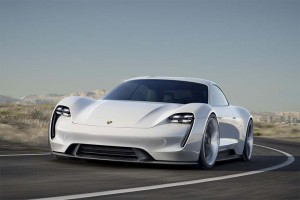
Workers at Porsche's Zuffhausen plant in Germany agreed to wage cuts in order to get the job of building the new Mission E.
The Mission E is not only a revolutionary car from a performance standpoint, it’s also breaking ground rarely trod in other ways: Porsche employees agreed to wage cuts in order to build the vehicle.
The German maker revealed its plans to build the new Panamera-like sedan earlier this month, saying it would spend $1 billion and add more than 1,000 jobs to its plant in Zuffenhausen.
What wasn’t revealed is that because the plants wage costs are higher than at Porsche’s plant in Leipzig, and at other parent company Volkswagen plants in Germany, workers agreed to some concessions to get the work.
“Employer and employees have jointly drawn up measures that have led to the decision of producing the Mission E model at Zuffenhausen,” a spokesman for Porsche told Reuters.
The moves included measures to increase the work week from 34 hours to 35, and to drop parts of a pay increase between 2016 and 2025, the magazine said. Porsche declined comment on details of the measures.
(Porsche on a Mission with new battery-electric supercar. For more, Click Here.)
The new Mission E is supposed to eliminate many of the issues – primarily range anxiety – that EVs deal with and give the Tesla Model S a serious competitor on that front as well as on the high performance end of the spectrum.
Borrowing a little bit of its styling from the iconic Porsche 911, the Mission E will be a four-door, four-seater, more in line with the current Panamera model.
The Porsche Mission E will deliver a maximum output of 600 horsepower, or 440 kilowatts, according to the maker, and will be able to launch from 0 to 100 kmh, or 62 mph, in 3.5 seconds. That’s actually about a half-second slower than the Tesla Model S equipped with the new Ludicrous Mode option.
In terms of range, however, the Porsche Mission E actually could top its Silicon Valley rival. It promises a range of “more than 500 kilometers,” or at least 310 miles, per charge, about 5 to 10% more than the highest-rated Tesla Model S. It wasn’t clear if the company was using U.S. or European calculations, however, as range and fuel economy calculations typically are as much as a third higher using EU testing procedures.
(Click Here for details about 20 models heading for the scrapheap.)
Significantly, Porsche says it will equip the Mission E to use the latest Level IV 800-volt charging system, which is twice as powerful as the current Level III quick-charge technology. That currently is offered in only a handful of locations anywhere in the world but battery-car proponents say it will be a critical development in making electric vehicle technology more competitive with conventional, gas-powered vehicles.
Using that technology, Porsche suggests it would be able to get an 80% recharge in just 15 minutes. While the maker didn’t reveal specific details, that would suggest the Porsche Mission E will carry somewhere north of 90 kilowatt-hours of lithium-ion batteries.
The German maker also noted the Mission E will be equipped with an inductive charging system that would allow an owner to simply pull the car over a coil system on the floor of their garage. It would be slower but not require plugging in.
(Average US gas price drops below $2. Click Here for more.)
Porsche is expected to share some of the underlying technology with sibling brands Volkswagen and Audi. The latter brand recently confirmed plans to launch a production version of the e-tron Quattro Concept SUV first shown at the Frankfurt Motor Show in September. That model will also offer more than 500 km range, Audi promised.

You can bet that the wage concession deal won’t get used again as the Zuffenhausen production facility is the very soul of Porsche. If they try to severely exploit employees there will be a national backlash and likely international backlash. You won’t find many Porsche customers bragging about their Porsche being built in Leipzig.
As far as the car, it’s an EPA mpg CAFE credit to reduce the gas guzzler tax that will be applied to all cars sold in the U.S. starting in 2025 for all car makers who can’t meet the absurd 54.5 mpg CAFE requirement. Virtually all large auto makers are unable to currently meet the 54.5 mpg requirement. Phase II of the three phase ramp to the absurd 54.5 mpg CAFE requirements starts in 2017. That is why auto makers are now rushing to get EVs and bicycles ready for sale to reduce the tax that all consumers will pay on all corporate models.